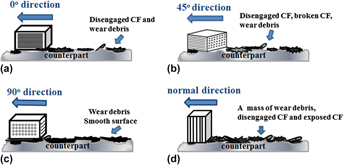Article contents
Influence of fiber orientation on the tribological properties of unidirectional carbon fiber reinforced epoxy composites corroded by 10 wt% sulfuric acid solution
Published online by Cambridge University Press: 02 February 2017
Abstract

This study investigated the tribological behaviors of carbon fiber (CF) reinforced epoxy (EP) composites immersed in 10 wt% sulfuric acid solution for different numbers of days. The tribological properties of the composites were evaluated as a function of their different fiber orientations (0°, 45°, 90°, and normal orientation). The CF/EP composites showed a favorable anticorrosion performance, as assessed by electrochemical corrosion tests, due to the tightly stacked CF. Meanwhile, the wear tests indicated that the CF orientation had a significant effect on the tribological performance. Composites with 45° CF orientation exhibited the lowest friction coefficient, whereas those with 90° CF orientation had lowest wear rate, which was 6 times lower than that of composites with normal CF orientation. Moreover, the surface microstructures of the worn surfaces were observed by scanning electron microscopy (SEM) to determine the corresponding wear mechanisms.
- Type
- Articles
- Information
- Copyright
- Copyright © Materials Research Society 2017
Footnotes
References
REFERENCES
- 8
- Cited by





